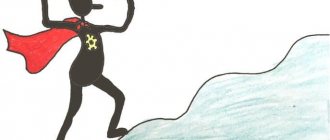The Internet, originally invented as a resource for communication and exchange of information between scientists from different parts of the planet, is actively developing. At the moment, almost 60% of people from all over the world can go online, and most of them have accounts on social networks, where various topics are actively discussed and heated debates are held on any topic. And since the online world is populated by the same people as offline, conflicts are inevitable. Increasingly, “bullies” are beginning to appear online, taking pleasure in humiliating other participants in the conversation. This phenomenon is called cyberbullying.
How to avoid bullying, how to protect yourself from offenders, is it possible to punish them? How to protect your children? Today we will try to understand these and other questions.
What is cyberbullying?
The term “cyberbullying” was coined by psychologists in the mid-1990s, when the Internet came to the masses, to describe bullying in the online environment. Cyberbullying can take different forms: insults, stalking, blackmail, harassment, slander, dissemination of personal data. All this causes psychological trauma to the victim.
Cyberbullying can be:
- Public: in the presence of viewers, for example, in discussions under a post.
- Personal: insults come through private messages.
Unlike regular bullying - bullying in the real world - cyberbullying occurs in the Internet environment, and often does not go offline. However, if we are talking about bullying within a team (for example, in a classroom), then the types of bullying successfully complement each other, aggravating the situation of the victim. But if in reality everyone sees and knows the bully, then online the process becomes anonymous.
It is important to note that cyberbullying is a long-term, systematic process. A single unflattering comment or angry response does not constitute bullying.
Who becomes the aggressor and the victim? As a rule, middle and high school students are more likely to experience cyberbullying , since it is during adolescence that children try different forms of dominance in a group. Teenagers do not yet know how to adequately express their feelings and emotions and release aggression in a socially acceptable way. However, this does not mean that any other network user cannot be subject to bullying.
Participants in cyberbullying
There are always multiple parties involved in the bullying process (both online and offline). Let's take a closer look at their portraits.
Aggressor
The person who attacks the victim, as a rule, is not confident in himself and is afraid that this will become noticeable. He wants to be superior to others, but not due to his own characteristics, but due to the devaluation of the victim. And if earlier physically more developed guys became bullies, then with the development of technology anyone can assert themselves at the expense of others.
Thanks to the capabilities of the network, the aggressor can hide under different accounts and also create accomplices, which increases the amount of harm caused to the victim. Anonymity on the Internet disinhibits attackers and allows them to do more than they could do in real life.
Victim
Anyone can become a victim of a cyber attack. Many people have encountered this phenomenon online in one way or another. According to statistics in Russia, almost 60% of children have already encountered this type of online bullying.
Media personalities are also familiar with cyberbullying firsthand. For example, the actively developing “cancel culture” (boycott of a certain person by the public) in Western countries is increasingly turning into real persecution for people, from which it is impossible to hide. And no apologies or justifications can save you from the wrath of the crowd.
As a rule, the victims are anxious, tense, and fearful teenagers. They have few acquaintances and friends who could come to the rescue and intercede. Low self-esteem only supports their belief that everything said by the aggressor is true, and there is simply no way to fight back. And high anxiety does not allow you to actively work on yourself. Thus, the aggressor quickly calculates the victim’s “pain points” and begins to systematically destroy his life.
Witnesses
It is important to mention another party involved in the conflict – witnesses. Even without being an aggressor or a victim, you can often see cyberbullying on the Internet. For a fragile child's psyche, this can become a serious test. Witnesses can take one side, becoming an “assistant to the aggressor” or a “defender,” or they can stand aside:
- “Helpers of the aggressor” are very conformist (agree with the majority opinion), are ready to carry out the instructions of the aggressor and are afraid of being in the place of the victim;
- “Defenders” are participants in cyberbullying, trying with all their might to stop the bullying and find words of reconciliation. They are non-conflict and want a comfortable existence within the team. These are people with normal self-esteem who are not looking for trouble.
There are various studies that conflict on whether boys or girls are more likely to be victims or bullies, so it is likely that gender is not a fundamental factor in cyberbullying.
Prevention and prevention
“If you don’t like what they write about you, don’t read,” “What did you expect from the Internet? Here everyone does what they want,” “Why take everything to heart?” — with similar remarks people try to support the victim of cyberbullying. But the child does not perceive virtual space as a threat. He has been immersed in the Internet since childhood: he associates games, cartoons, and fairy tales with pleasure. Therefore, having fallen into the aggressor’s network, he is left alone with him, not knowing how to act. And asking for help is a shame.
“Teach your children to respect confidentiality: do not post personal information or photos online that could damage their reputation and self-esteem, and do not share your location with strangers. If a teenager does become the target of bullying, do not reproach him: I told you so, but you didn’t listen. Create a safe environment by removing offensive messages and limiting access to violent videos. Block unwanted sites, but don’t take away gadgets, otherwise the child will feel like an outsider.”
I'm being trolled, what should I do?
- Share the problem with those you trust: relatives, friends, older comrades.
- Ignore an isolated incident of cyberbullying.
- Don't take revenge. As already mentioned, any negativity affects your well-being. If you can’t do anything, try to switch to something positive: visit a site with cute pictures, laugh at a funny video, write to a loved one.
- When they start to deliberately touch your nerves, tell them directly so that the person will stop.
- Laugh. Try to turn a mean comment into a joke. Mentally dress the troll in a clown suit, imagine how funny he makes faces, artificially cries or dances absurdly, as if in a circus.
- Save evidence: message screenshots, photos, videos.
- Block those who have a bad reputation online. This can be done in the phone settings, on special platforms. Close your profile, add only people you know as friends.
- If you are intimidated, extorted money or threatened with life/health, you need to contact the police.
- Report trolling to the content provider.
- If you witness cyberbullying, stand up for the victim, but do not engage in destructive dialogue. Invite your like-minded friends and together apply positive pressure on the aggressor. Create a separate chat to support the victim and exchange experiences of online behavior.
Types of Internet bullying
Cyberbullying online comes in various forms and names. Let's try to understand each of them.
Trolling
Not really bullying. This is a kind of tough challenge to a competition of humorous skills. As a rule, it doesn’t matter to a troll who to picket with or for how long. If the response comes with a more witty remark or the comment is completely ignored, then the “comedian” will go looking for another platform for his performance.
Flaming
It's not bullying either. A single outburst of anger towards a person, expressed through an offensive comment or harsh criticism. As a rule, the authors of such rude messages do not need a response. They poured out their reaction to your product (post, article, video, photo, etc.) and moved on, forgetting about your existence after 2 minutes.
Heating
Derived from the English word “hate,” it is full-blown bullying against a person that unfolds online. The victim is literally bombarded with offensive messages and comments through all possible sources - social networks, instant messengers, video hosting sites, etc.
Harassment (harassment)
Harassment with obvious sexual overtones. The person begins to receive messages with photographs and videos of a sexual nature, corresponding calls and confessions. The downside can be a form of revenge in which a once close person begins to threaten to post or posts intimate photographs and video files of the victim for public viewing.
Dissing (slander)
Spreading false information and rumors about the victim in order to cause maximum reputational damage. For these purposes, fake correspondence and photoshops can be created, and posts can be written with deliberately distorted details.
Forgery of identity
By hacking a user's page or creating a copy of it, the spread of false information and denigration of a person begins. On behalf of the victim, offensive messages are sent to friends, teachers (if we are talking about schoolchildren), etc.
Boycott
It often happens within a real team. The victim is excluded from general groups and chats, depriving her of the opportunity to participate in discussions and express her opinion. Any little thing that distinguishes a child from the rest can be a reason for a boycott within the class.
Disclosure of personal data
Publishing on the Internet any information about a person that is not in the public domain can lead to dire consequences for the victim. For example, it is enough to disseminate the home address of a famous person to cause her enormous trouble, even to the point of changing her place of residence. Also posting photos of an intimate nature or a source of income on the Internet without the person’s permission, etc. is a type of bullying.
Cyberstalking
Prolonged online harassment, accompanied by death threats and sexual harassment. The aggressor literally follows his victim everywhere - he marks himself in photographs, comments on any activity on the Internet, joins the same groups, sniffs out information from friends.
Open death threats
Comments and messages directly or indirectly contain descriptions of physical violence. Attempts are made to track down the victim in the real world, and “shooters” are assigned.
Cyberbullying often does not boil down to one type of bullying; it is multifaceted - it all depends on the imagination of the persecutor.
What kind of bullying can you face on the Internet?
We conducted an anonymous survey on social networks, in which 33 people participated. In it, we asked those who have experienced cyberbullying to talk about their experiences. It is also worth noting that the link to the survey was also published in specialized groups where people who have been bullied on the Internet communicate with each other.
Most often, users encountered humiliation on the Internet (can be interpreted as insults or “trolling”) - this option was chosen by 68.8% of respondents. The option “I was threatened” was chosen by 15.6% of respondents, and “I was blackmailed” – by 6.3%. Another 3.1% of respondents noted that they encountered both threats and humiliation. There were also those who answered that they themselves insulted others: 6.3%.
Results of a survey on social networks
We also wanted to find out exactly how online bullying happened, so we asked survey participants to talk about their experiences. Many noted that they encountered ethnic insults, the spread of slander, and intrusive messages from “fake” pages.
“My classmates created a group and called me by an offensive nickname, which they themselves came up with. They posted offensive photoshopped pictures there, wrote derogatory posts and discussed me.”
“They made a page with my avatar and name, which was filled with porn content. Then they “knocked” on all my friends, passing it off as my new page.”
“I was blackmailed by publishing intimate photographs of myself. They even sent a few photos to friends. The blackmailer didn’t wait for any reaction from me and then fell silent.”
“They threatened to take my life for my political and moral beliefs.”
“I refused to become the mistress of one man, and a married one. He hacked my page and created a love correspondence with himself. Provided “evidence” to my husband. My family fell apart, and that man is still trying to “seduce” me. He creates “fake” pages to get to know me, writes about his feelings and assures me that I won’t be happy without him.”
“I decided to end my relationship with my boyfriend because there was nothing good in it anymore. After that, he used my fears and weaknesses to force me to return. He threatened to commit suicide and constantly wrote on social networks from “fake” pages. I barely had time to block these pages. In addition, he even gave my mother an engagement ring. Apparently, he decided that she would convince me to marry him.”
The survey participants also noted that they suffered from these situations: they were very nervous, felt lonely and unnecessary, were afraid that it would always be like this, and doubted that they should continue to live.
Why do people do this?
The reasons for starting to pursue a victim can be completely different - resentment, envy, anger. But the catalyst for the transition to active action is the seeming anonymity and permissiveness in the Internet environment.
Some aggressors were initially afraid of being among the victims themselves and therefore attack first. This often happens to witnesses to bullying. By humiliating other participants, they try to join a stronger group, or even lead it. If the goal is precisely to establish oneself as a leader, then the offender is more likely to use his personal account rather than an anonymous persona.
Representatives of other cultures and nationalities often become objects of ridicule. The lack of competent work to unite the team at school can lead to pronounced conflicts on interethnic grounds.
Anonymity and virtually limitless possibilities allow insecure, weak, and angry users to show themselves as strong and smart on the Internet. Such people, as a rule, choose their victims among those who are superior to them in some way.
Revenge is also a common cause of cyberattacks. An offended friend, partner, ex-boyfriend or girlfriend may initiate bullying to take revenge for their own grievances (whether real or imagined). Moreover, close relationships at one time allowed them to learn a lot of personal things about the victim, which worsens the latter’s situation.
The dangers of online bullying
The opportunities that the Internet provides exacerbate bullying and make it much more sophisticated.
There are three main differences between cyberbullying:
- There are no time or geographical restrictions. When a person is bullied at school, college or work, the process does not continue around the clock. In this case, the circle of bullies is limited to an educational institution or office. There are no such boundaries on the Internet: the end of the school or work day does not stop bullying, and distance and lack of personal acquaintance do not prevent one from joining in the bullying. Online bullying does not give the victim any respite.
- It’s easier to attract new members and increase bullying. Information on the Internet spreads spontaneously and at high speed. In reality, the spread of slander and rumors takes time: they must be discussed by the majority. In addition, fear prevents many from spreading rumors. On the Internet, messages can be sent out instantly and bullying can reach a huge audience. Once such a process is started, it is difficult to stop it.
- There is a stronger sense of impunity for bullying. To spread it, you don’t have to reveal your personal information; you can do it from a “fake” (not real) page, maintaining anonymity. Under such conditions it is easier to join in the bullying than in reality.
The danger and consequences of cyberbullying for teenagers
First of all, enormous damage is caused to the victim of cyberbullying. Social ties are broken (at least that’s what it seems to a teenager), anxiety increases, headaches and nightmares occur, and mood drops. The teenager may develop depression and have suicidal thoughts.
The aggressor, fulfilling his unhealthy desires over and over again, feeds negative traits and aggravates his psychological problems. Remember that a mentally healthy person will never bully people, either in real life or in virtual life. Subsequently, such a teenager will find it difficult to build healthy relationships with other people.
Witnesses are also traumatized by being in an environment where conflict occurs. Most children are forced to take the position of an aggressor in order to avoid becoming a victim. If a “defender” appears in the group, then he has to withstand enormous pressure from the aggressive majority.
Unfortunately, it is in schools that cyberbullying most often begins. Therefore, parents and teachers should pay close attention to the atmosphere inside the classroom.
Help is needed not only for the “victim”, but also for the “buller”
If you experience cyberbullying, you should definitely seek help, psychologists unanimously assure. Especially if a child is suffering from bullying.
“Often the child does not yet have the skills to cope with difficult situations. Parents should tell their child about what cyberbullying is and how it manifests itself. And also convey that in case of bullying, the child needs to tell them, the teacher or the school psychologist about it. Parents must explain to the child that bullying is not his fault. I explain to very young children that children who bully “simply don’t know how to be friends,” with teenagers we talk about the fact that aggressive children have their own unresolved psychological difficulties, which usually come from the family,” says Yulia Belykh .
First of all, parents should think about whether their child has enough communication, notes Marina Nachkebia. It is often difficult for children to leave a certain group, because “then there will simply be no one to communicate with,” and for this they are ready to endure attacks. If a child feels provocations addressed to him, it is important to stop communication in a timely manner, without making excuses or entering into a game of “who is stronger.” If a child has already become susceptible to bullying, then it is important, first of all, to give a feeling of security and, importantly, to understand the reasons for the emergence of such relationships in his life.
“Oddly enough, in situations of bullying or cyberbullying, help is often required not only by the victim child, but also by the aggressor, as well as those children who are passive participants in the events. They are all in one way or another in a situation of violence and psychological distress,” emphasizes Nachkebia.
As noted by the acting Director of FIRO RANEPA, Candidate of Pedagogical Sciences Evelina Alieva
, there are a number of signs that parents can use to determine that their child may be a victim of bullying.
“Parents should pay attention to the following signs: the child begins to talk less, as if he is hiding something, the way he dresses has changed, the circle of friends has changed,” she lists.
In order to independently solve the problem of bullying, a child must have high social competence, but not even all adults succeed in this. “Therefore, the child must know one thing: he must be persistent in his desire to seek support and help from other people (friends, family, psychologists). Under no circumstances should you succumb to the imposed feeling of guilt,” says Aliyeva. “Witnesses of bullying, as well as victims, often experience these destructive feelings (“I saw, but kept silent”).”
Help for children with experience of victimization (becoming a victim) can be provided not only by adults, but also by their peers: classmates, friends, acquaintances. For adolescence, peer support is sometimes more important than adult support, and the importance of friendly support increases over time. Children often share problems primarily with friends. Therefore, it is necessary to teach teenagers mutual assistance in situations of cyberbullying, the teacher believes.
“Prevention of cyberbullying should be carried out with younger teenagers, that is, before sensitivity to it decreases. Formats of training work with high school students, where they share their opinions, with examples from personal experience, social ideas and reflection, have shown their effectiveness. It is necessary to defuse tension in the classroom. It makes sense to involve everyone in this work: victims of bullying, instigators of bullying, witnesses to this process,” she says.
Whether to close an account on a social network or not is a decision that each person must make independently, adds Aliyeva. It’s worth considering that the wider your network of contacts, the greater your chances of receiving support – albeit not in general chats, but in private messages. “Leaving groups can be recommended in cases where you are in a community with deliberately aggressive content - let these chats take place without you, in a “parallel universe,” says Evelina Alieva.
Leading researcher at the Center for Strategy, Design and Legal Support of the FIRO RANEPA, Candidate of Psychological Sciences Elvira Vandanova
believes that conversations about how to behave on the Internet and how to act in the event of bullying should be taught from a very young age. “Children of primary school age should be told about this by teachers (at parent-teacher meetings) and parents (periodic conversations),” she says. – Not only on November 11, on the Day against Cyberbullying, we should remember this phenomenon. You need to know about the legal aspects of such activities, and about methods of combating, about fines for insulting on the Internet.”
What if I am a victim?
If you are faced with bullying, then immediately take measures to preserve your own self. The sooner you start building your defense, the less damage they will deal to you.
- You can ignore the first message or send a complaint to the developers of the social network or messenger. If this was regular trolling or flaming, then ignoring will be the best way to protect yourself. Remember that you cannot be perfect for everyone, and if so, then why try for the sake of someone you barely know or a complete stranger?
- If you feel that you are being bullied and humiliated systematically, protect yourself from this contact. Almost all instant messengers and social networks have the “File a complaint” and “Blacklist” functions.
- Even if you communicate with a loved one, try not to transmit personal information or anything that could be used against you through social networks and instant messengers. Remember that anyone can be on the other side of the screen.
- Don’t be afraid to report what’s happening to your senior management; try to resolve the conflict at an early stage. Don't be afraid to discuss this problem with colleagues, friends and loved ones. The more people who learn about the bully early in the bullying process, the less harm the victim will suffer.
- If the job changes, and aggressors appear again and again, conduct an audit of your personality. What qualities attract pursuers so much? Perhaps a little work on yourself will allow you not only to free yourself from bullying, but also to reach a new professional level
Pedophilia and sexting: what else is dangerous about the Internet?
On the Internet, a child can encounter not only bullying, but also even more dangerous things, warns psychologist, psychotherapist, head of the “Psychology of Communication” department of the business speech company Maria Eril
.
“This topic is associated not only with bullying, but also with stories of a sexual nature. For example, pedophilia. There may also be deception with the aim of luring money out. All these problems are subject to discussion in the family. Just as in Soviet childhood we were told about road safety rules, today we need to consider cybersecurity,” she says.
“One type of cyberbullying is sexting. A child may be extorted for intimate photographs through blackmail or psychological pressure. Such situations are very dangerous. The child’s psyche is not yet stable enough, and therefore it is difficult for him to cope with such problems on his own. And there is a high risk that after something like this, turning to a psychologist will become a necessity,” adds Olga Sokolova.
“Requests for fundraising and photos with the CEO”
What should you not post on social networks to attract an employer?
At the same time, it is not at all necessary to make an account on social networks private, says Maria Eril; it is much more important to maintain a trusting relationship with your family and always be on your guard.
“Should you make social media accounts private to avoid cyberbullying? It greatly depends on what the child is like and what he is like. He may be an extrovert, focused on developing in social networks, a novice video blogger, and then the idea of closed social networks will not appeal to him and will not suit him. In my opinion, it is possible to build strategies for correct online behavior without this. The presence of parents and a trusting relationship with them is enough,” says Maria Eril.
Parents should talk openly with their child before he registers on certain Internet resources. For example, when registering on a new social network, offer to set up a profile with it and use the options: hide receiving messages from unknown users, open photos only for friends. This will protect the child from strangers and reduce the risk that he will be subjected to online bullying, says Olga Sokolova.
“In addition, photographs or pictures published by a child can be linked to the geolocation from which the child posts them. And often these are precisely the places where the child is constantly or periodically appears, that is, home, school, sports section, etc. Using such photographs, you can track the person who published this content, and therefore it is necessary to warn children to be careful before registering on any Internet platforms. Even the smartest child should be reminded that they cannot post any documents - passports, birth certificates, boarding passes on the plane,” she reminds.
Shutterstock/FOTODOM
My child is a victim
All parents want their children to be healthy and happy, to have friends, a good class, the best teachers, and to remember their school years as a fun time. However, this is not always the case.
Unfortunately, many children face bullying at school, in the yard, and on the Internet. In Russia, according to statistics, 76% of children do not tell their parents that they have problems.
Signs that a child is being bullied online:
- The child began to spend less time on the phone or, on the contrary, began to use it more often.
- After being on the Internet, the teenager is depressed, irritable, and upset.
- The child closes down, does not want to make contact, does not want to talk about who he communicated with and about what.
- Academic performance is falling.
- The child's appetite is impaired, headaches and other psychosomatic disorders appear.
Having noticed changes in the behavior of a teenager, parents need to try to get him to talk about what is happening . There is no need to put pressure and spy on the child: just say that you are always there and ready to help him. It happens that it is difficult for a child to admit that he has become a victim of bullying, especially if he is blackmailed with photographs or personal information. Invite him to write you a message or record an audio message, promise not to punish or scold him for what he tells.
As soon as you have confirmation of bullying, tell your child that this is not a normal situation and you must stop it together.
Modern technologies can help in this situation. You will either check whether your child is being bullied offline or online, or obtain evidence of bullying so that you can use it against the aggressor in the future. See what apps your child spends on and how much time they spend, know where they are and listen to what's going on around them with the Where Are My Kids app.
Protection plan
- Teach your child to block unwanted visitors to his social networks. Find together the “complain” or “add to blacklist” functions - they are available on almost all Internet resources. For “passing hooligans” this will work almost instantly. If rumors, videos or photos are spread through a certain community or general chat where there is no way to directly remove insults, contact the administration of the community or site with a request to remove the unwanted content.
- Set up a page on a social network, increase its security level, and delete all personal information that may become available to aggressors. Prohibit other users from tagging your child in photos and videos.
- Do not respond to cyberbullying, do not engage in conversation with the offender. The aggressor’s task is to get as many emotions as possible in response, to feel superior. Ignoring his actions will eventually cause him to either make a mistake for which he can be prosecuted, or he will lose interest in the victim.
- Try to find out who exactly is hurting your child. This will allow you to punish the offender in real life.
- Take screenshots of correspondence, comments and other materials that will allow you to confirm your words. Yes, in Russia at the moment there are no laws in the Criminal Code of the Russian Federation that would directly punish cyberbullying , however, if there are threats or suspicions of harassment, this can be considered as grounds for initiating a criminal case. You should also remember that the state requires notarized screenshots of the pages. But if bullying occurs within the school walls, ordinary printouts will be enough for the administration.
- Since cyberbullying often happens within the classroom or school, do not be afraid to involve the class teacher, social teacher, psychologist and administration in solving the problem. It is necessary to pay attention to this problem to help children improve relationships in the classroom and stop bullying.
Remember that trusting and warm relationships in the family will allow the child to turn to you for help as early as possible and receive minimal harm from cyberbullying.
Types of cyberbullying
There are several forms of cyberbullying that can be used against a victim. All of them have an equal impact on a person and can lead to tragic consequences.
- Bullying. Bullying refers to the systematic violence of one person or group of people against the victim. Online it can be expressed in the form of sending messages with offensive nicknames and threats, hacking personal pages on social networks and spreading false rumors. This kind of cyberbullying is most often practiced in schools.
- Trolling. With such cyberbullying, the goal becomes a banal provocation. They try to deliberately piss off the victim by sending various messages with unpleasant content. As a rule, bullies do this solely for their own pleasure.
- Mobbing. The main feature of this form of cyberbullying is its mass nature - the victim is systematically bullied by several people at once. They may send messages ridiculing you, point out flaws in your appearance, or simply act hostile. Such actions are usually aimed at forcing a person to leave the team.
- Flame. The main role in such cyberbullying is played by messages in the format of verbal warfare. The victim is insulted and provoked in order to develop the conflict even stronger even if it has already been exhausted.
My child is an aggressor
As you and I already know, aggressors are people who seek to assert themselves at the expense of a weaker victim. If you notice that a child is showing aggression for no apparent reason, is offending other children on the street, or perhaps trying to hurt you, you should not let the situation take its course. A simple punishment “a week without a phone” or “stand in a corner” is not enough here, and in some cases it can only do harm. Aggressive behavior in a child under three years of age is a normal, unconscious reaction, but the older a person gets, the better he learns to manage his emotions, including anger.
Thus, if a child is too aggressive, it is necessary to undergo an examination by a psychiatrist to rule out pathology of the nervous system. If the child is healthy, then you will have to work directly with relationships within the family and with relationships within the class (if there is evidence of problems at school). Here, of course, it is necessary to enlist the support of teachers and school administration. It is necessary to understand what exactly the child is trying to achieve with his behavior - attracting attention while in a vulnerable position, or trying to take a leadership position.
If a teenager is vulnerable, then it is necessary to help him get support and help without using force. Praise him often for correct behavior and ignore aggressive behavior. Learn to cope with outbursts of anger and aggression in socially acceptable ways (hitting a pillow, counting to ten, etc.). Perhaps enroll him in a sports section, where he can splash out his energy outside.
If you have a leader who strives for power, help him understand that fear is not a sign of respect and love. Show that an attentive, calm and balanced leader will always be more valuable than any tyrant. Also try to find an opportunity to use your leadership skills, for example, by inviting him to join the student council.
Reasons for cyberbullying
People often bully others when they want to gain recognition in a virtual community, show power and strength because they cannot show it in real life, or simply escape boredom. Bullying helps them get attention.
Cyberbullying against a specific person can be due to conflict based on national, political and cultural differences or a painful break in a relationship. People poison each other out of revenge, anger or envy, not having the courage to express their complaints in person.
Paradoxically, the cause of cyberbullying is cyberbullying itself or the fear of it. Victims of online insults (including potential ones) become aggressors because of the desire to take revenge on the offenders or to protect themselves from the attacks of others - “Now the victim is not me. Now I decide!
When mass bullying happens, instinct tells you to join the majority and behave the same way, so as not to end up on the side of the weak.
Will the law protect you?
At the moment, in the Russian Federation, a law on combating online harassment is under consideration. However, since cyberbullying is quite diverse in its manifestations, you can try to bring offenders under other articles of the Criminal Code of the Russian Federation.
Today, there is judicial practice of punishing cyberbullies administratively and criminally for libel (Articles 128.1, 298.1 of the Criminal Code of the Russian Federation), insult (Article 130 of the Criminal Code of the Russian Federation), threat of physical violence (Articles 161–162 of the Criminal Code of the Russian Federation) , incitement to suicide (Article 110 of the Criminal Code of the Russian Federation) and indecent acts of a sexual nature (Article 135 of the Criminal Code of the Russian Federation).
In order for the case to have grounds, it is necessary to preserve as many facts of the persecution as possible - correspondence, screenshots, etc. All this must be notarized, since at the moment the Code of Judicial Procedure already sets out clear criteria for attaching screenshots to the case. It is also necessary to indicate and record the exact dates and times of the events that occurred and provide a link to the required page.
How to recognize cyberbullying
Any humiliating, offensive message that threatens human safety, as well as video clips and photographs posted on the Internet without the consent of the victim, in essence, can be classified as cyberbullying.
The phenomenon of cyberbullying also includes the creation of fake user profiles and Internet resources whose activities are aimed at denigrating a potential victim.
To understand the essence of the phenomenon of cyberbullying, we note that its participants are the following persons, among whom role positions are distributed:
- aggressor (offender);
- victim (passive or aggressive);
- witness;
— defender (optional element of communication).
Ways to deal with the problem
The likelihood that a child who has become a victim of bullying will turn to adults for help is very low. Most often, parents have to recognize the problem by its signs. But, if a request for help occurred, then this indicates a trusting relationship in the family. In this case, it will be easier to solve the problem.
Here is the algorithm of actions:
- First you need to have a conversation with the child. A good time and place is selected for this. It is very important to be sincere and attentive - this will create more trust. Try to control your emotions before and during the conversation.
- Make your child understand that you love him and are always ready to help.
- It cannot be said that the cyberbullying that a child faces is not the worst thing that could happen to him. He must understand that any problem is worth attention and should be discussed.
- Gain trust by comparing a situation to one that happened to you. Yes, there was no Internet in your childhood, but you could be bullied on the street.
- After the child has confided in you, you can discuss the problem in detail. You need to listen carefully to the story and not interrupt.
Dangerous consequence: suicidal thoughts
After a heart-to-heart conversation, you can take action. You can respond to cyberbullying by teenagers or adults in this way:
- Avoid places where a person is subject to bullying - change your phone number, email address, and delete your account on social networks.
- Report fake pages to the administrator.
- Keep all evidence of bullying - photos, videos, screenshots.
- If you manage to identify the offender, contact his family and explain the situation. To do this you will need to show evidence.
There are situations in which bullying goes beyond all limits and the child is in real danger. In this case, it is better to contact law enforcement agencies.
It is important for someone who has become a victim of cyberbullying to learn to ignore name-calling and deal with it more calmly. It is also important not to object to offenders, because this will only spark their interest. If problems arise in the virtual world, you need to try to spend more time in the real one.
The conversation with the child should be calm and confidential
How is cyberbullying?
Zhasospirimder virtualy ortada ozgelermen tanysu, arturli aleumettik rolderdi atkaru, normalardy iger arkyly aleumettenu protsessinen otedi. Digital technology, akarattyk-communication technologylarynyn taraluymen kadymgi aleumettik-fizikalyk tyrshilikte bolatyn barlyk communication virtualy platformlard "kaytalanady", kade virtualy baylanys arkyly kusheyedi, keyde bұ Zylady, beryak zhalpy alganda kondeliktі karym-katynas jan erekshelikterimen tolygyp keledi. Internet payda koptegen adamdar ushіn resurska aynalyp, kosymsha aleumettek mumkіndikter ashty yes, “virtualdy baylanys” birtindep adettegi kubylyska aynaldy. Internet tags anonimdіlіk former omіrdegі bascalardyn karsy shyғuy men totaryp tastauynan aynalyp otіp, zhastardyn arturli aleumettik rolge enіp, oz-ozіne t әzhiribe zhasauyna zhol ashty. 2005 zhylgy malimetterge karaityn bolsak (Resey), Internet tags zhasospirimderdin tortten bir boligi ozderinin zhynysy, zhasy, ethnikalyk toby, sayasi kozkaras turali malimetti burmalap korsetken, al olardyn zhartysynan kobinde birneshe elektrondyk poshta men lakap aty bar bolyp shykkan.
Baska derekterge sәikes, zhasөspіrіmderdin 39% Internet zhelіsіnde bireumen kalzhyңdap oynamakśhy bolgan nemese zhedel hut zhazyskanda bөgde adam bolyp tanyskan. Bіr zhagynan, búl ozі turaly kobіrek bіlgіsі keletіn, ozіnіn іshkі dunіsіne syrttan karakysy keletіn zhastarga kyzyk experiment more ïktimal. Alayda, ekіnshі zhagynan, bіz қozғap otyrgan “virtualdy katynas” kogamda zhana kauipter men problemlar tudyrdy. Mysaly, zhelіd anonymous bolu zhassospіrіmnіn internet nemes kundelikt omirde dal ozі siyakty “role oinaushy” adammen keziktirіp, túrli kylmys pen zán buzushy Is-areketterge, teris adet-kylyktarga itermeleuі mүmkіn. Өзінін қылмыстік pғуылн оrндау үшін ьүркіншік атпін ізінің қылмістік ұрлагѓн, psihologiyalyқ-karzhylyқ қысім көрзік қысім көрsetіп, bопсаlаgаn үаgdaylar yes kop.
Atalgan kurdeli maselelerdin togysuynan alemnin koptegen memleketteri men halykaralyk qauymdastyktyn aldynda internettі zhane virtualy communicationslardy kenіnen koldanu kezinde os communications zheny yelep, koғamga lady paidaly etu, koldanushylardyn qauіpsіzdіgіn kamtamasyz etu, cyber ethics kalyptastyru mіndetі tur. “Shynayy” zhane “virtualdy” alemdіқkarama-kaishy koyushylardyn koptep taraluyna karamastan, os ekі kubylystyn arasyndagy nakty shekara aikyndalmagan. AKSH Mississippi States Adilet Department of Cyberkylmys (Akparattyk technology koldanatyn kylmys) Bolіmіnіn criminologist-zertteushіsі R. Mahaffey, XXI ғазѓрда ғазірDA ініте үмі қызқти оқалар, qauіp-qater men qylmyskerler tүyіsedі, onda atylatyn oktar zhasandy bolganymen, olar adamdardyn zhanyn zharakattauy mumkin degen pikirge keledi.
Birikken ulttar Ұyymy cyberbullying maselesine үlken nazar audaryp, halykaralyk dengeyde tiisti sharalar kabyldanyp otyr. UNICEF akparatyna sәikes, cyberbullying degenіmіz digits technologylardy koldanu arqyly adamdy qorqytu nemese kudalau. Ol aleumettik jellyerde, arturli hat-khabar almasatyn kosymshalarda, oyyn platformarynda zhane yyaly phone arkyly yes boluy mumkin. Bunday birneshe ret kaytalanatyn іс-әрекетін махсаты кудалап урған аdamы үркітіп-крқыту, ашуын тиій зме өзге өлдің алдынDA maskaralau. Ogan mysal retinde:
— aleumettik jellyerde zhalgan akparat taratu nemese bereudin adepsiz nemese zheke fotosuretterin zhariyalau;
— khabar alysatyn platformar arkyly bireudin zheke basyna kol sugyp, kokan-lokky korsetetіn, qauіp tondіru sipatyndagy habarlamalar zhiberu;
— ozin aleumettik zhelide bireudin atynan tanystyru zhane son atynan adepsis khattar zhazu.
Shynay omіrdegі adamnѣ zhe basyna tiіsu men cybershabuyl kobіnese qatar zhuruі mumkin. Browse the Internet to select the numbers below and select your dialer. Ol factor of cyberbullying is not important.
Cyberbullying alys-zhakyn shet elderde adamdy aggressive forma korkytyp-urkitudin Internettіn mumkіndikterin koldana otyryp tez taraluymen korіnedi. 1993 lived a Norwegian psychologist D. Olveus Balalar men zhasospirimder ortasyndagy kysymnyn zhalpyga birdey kabyldangan anyktamasyn berdі, yagni “bullying - bilik pen kush tensizdіgіnen tu Please note that you should use aggressive measures. Bul takyryp onyn saldarynyn kurdeli boluy, ken taraluynan balalar uzhymdary kontextinde en kop talkylanatyn takyryptyn biri bolyp sanitary.
2021 zhylgy kantardagi zhagday boyynsha internet kysym zhasalgan AKSH-TAGY eresekterdіn ulesі
Kazakhstan ratyn үйдің aulasynan bolek, qorkytyp, keleke kyluy yktimal Internet kenistigі men onyyn әrtүrl platformars payda boldy. Adam's aggresivti tүrde qysym zhasau zamanaui technologylardyn qosyluymen zhan sipatka iye boldy. Cyberbullying dep atalatyn bugde bіreudі qorlaudyn bul tүrі Europe men AҚШ-ta balalardyn, ata-analar men mamandardyn alandaushylygyn tudyrdy. Internet tags as well as processing of ereksheligi – ol zherden eshte zhogalmaydy, zhogalgan kunnіn ozіnde kalpyna keltiruge bolada. Virtualda kenistiktegi belg_sizdik kop adamdy arүrli sheshimderge itermelaide.
Cyberbullying tikels ykpal etetin en osal top – zhasospirimder. Aleumettik zhelilerdin tanymaldygy artyp keledi, onda paidalanushy zheke profile ashyp, arturli akparattardy zhariyalay bastaydy. Sondyktan zhasospіrіmder men zhelіnі endi paidalanyp zhurgen eresekter, zheke shekarany n byzyluy, kolzhetimdі akparatta teris paydalanu, kupiyany n saktalmauy siyakty tәuekelderge dayyn Bolmauy mumkin. Zhasospіrіmderdin 72% — dan astama aleumettik zhelіlerde zheke profilge ie. Balalar ozderinin surname, zhasyn, mektebin, zhelіge koyady, al ushten birinin profiles baskalarga aśhyk korsetіp turada. Shetelde balalardyn 62%-y zheke fotosuretterin basqalarmen bolisedі eken. Zertteu boyynsha, Internette zhagymsyz zhagday tuyndagan kezde 6-9 zhastagy balalardyn 77% ata-analarynan komek suraidy, al 15-17 zhastagy balalardyn 54% мәсалің sheshimіn ozі ta pkysy keledi. Sondyktan balalardyn jelly degi belsendiligimen qatar onyn kauiptiligi, boldyrmau, wife turaly uyretu, agartu zhumystarymen ainalysu kazhet.
Euroodak elderinde cyberbullyingke karsy kureste qylmystyk nemese azamattyk zhauaapkershiliktin aldyn alu karastyrylgan. Zhana Zealand zhelіde korlagany ushіn bass bostandygnan ayyruy mumkіn algashky memleket boldy. AKSH-ta cyberbullying is under threat in the English Civil War. Cyberbullying zertteu ortalygynyn malimetei butiynsha, 44 shtatyn 50-inde internet tagi kudalau ůshіn kylmystyk zhauapkershilik bar. Germanyda cyberbullyingt zhekelegen taraptary zhazalanada, ol 10 zhylga deyin bass bostandygynan ayyru zhazasy nemese azamattyk құқык құқык ұзушылћ bolіp sanalady. Ontustik Korea, France Internet platforms of aggression and katysty kusheytu zhumystaryn zhurgizude. Kazakhstan's practice of cyberbullying is an aleumetic phenomenon of retinde bar, take into account the current code of law of women Arnalmagan.
2021 zhyldyn qantarynan AҚШ-ta cyberbullying bolgan online platformar ulesi
Resey beybitshilik kora "Kauipsizdik 2.0" ortalygynyn monitoring ne saikes zhelіdegi balalar men zhasospirimderge alimzhettik kobeygen. 2021 zhyldyn birіnshі zhartyzhyldyғynda wasps ortalyk kameletke tolmagandardyn cyberbullying boyynsha 1839 okigany tirkegen, ol otken zhylmen salystyrganda 100% dan asyp ketken.
2017 zhylgy zertteu boyynsha australialyk 5 zhastyn 1st aleumettik okshaulangan, qauip-katerge ushyragan nemese internet zorlyk-zombylyk korsetkenіn khabarlagan. Zhastardyn 55% jelly kysymnan keyin ata-anasynan, 28% dostarynan komek suragan; 38% zhelіdegi accounts in bұғattagan; 12% wasps zhagday turaly website khabarlagan eken.
15 pen 29 zhas aralygyndagy kanadalyk internet koldanushylardyn 17 payyzy (nemese 5 adamnyn 1-i) aldyngy bes zhyl іshіnd cyberbullyingtin құрваны млғанн aitkan. Kezdeysoq zertteu barysynda 14%-dan astama basqa adamnyn cyber kysym zhasaganyn moyyndady zhane matindik khabarlama, elektrondyk poshtalar arkyly kaueset onyyn ekop taralgan turi bolyp shyk an. Kyzdar (40.6%) er balalarga karaganda (28.8%) kobirek kibershabuyldyn kurbany bolgan, oyitkeni qyzdar aleumettik zhelige uakytty artyk zhumsides, al uldar beine oyyndar oh nauga beyim keledi eken. Okshaulanay kezeninde zhasospirimder men balalar arasyndagi zhekkorushilik, tozbeushilik pen aggressive katynas osip ketken.
Zhalpy alganda tomendegi statistics zhekelegen elderdegi cyberbullying turaly zhandyk alandaushylykty korsetedi. Cyberbullying turaly alandau Swedenada zhogary, onda respondentterdin 91 payyzy cyber kysym turaly khabarlagan. Ipsos malimetteri boyynsha, bukil alemdegi respondentterdin 75 payyzy cyberbullying ku bolgan.
2018 zhylgy sauirdegi zhagday boyinsha alemnin zhekelegen elderindegi cyberbullying turals complaints aqparat
And, bullying degen bugin paida bolgan kubylys emes. Internet or shykpagan command adam balasynyn birin-biri keketip-mukatuy, shady trampled shettetuy, zheké bostandygyn shektep, qysy corsetoui, tur-tusine, nas Or change the thickness, or change the material, remove the valve, or remove the valve. anak nәrse. Wasps oraida alemdi koya turganda kazakta zhelden bar kagytpa kalzhyn, dostak azilo-kulkinin orna bir Bolek. The current aggressive form of the solution to the problem of money loss. Bugіngі uakytta wasps құbylystar “cyberbullying” degen atpen zheke zertteu salasy, ақPARattyқ technology taraluyna baylanysty zhana sipatka koshken kysym zhasau, korlau, korkytu, kokan-lok How to corset korsetudің terminіne ainaldy. Ol problem os kunde balalardan bastap eresekterge deyin zhas aralygyn kamtytyn, kundeliktі omirdin barlyk aspectilerin katysty bolp open.
Who suffers from cyberbullying
Despite the popular belief that this problem is childish, no one is immune from it. One study shows that 40% of adults have experienced some form of cyberbullying. However, teenagers are indeed at greatest risk, primarily due to the seriousness of the possible consequences. The peak of the threat occurs in grades 5-7. It is also important that in 41% of cases cyberbullying continued offline or arose from a real conflict situation. According to Kaspersky Lab., 26% of online conflicts escalated into real ones.











